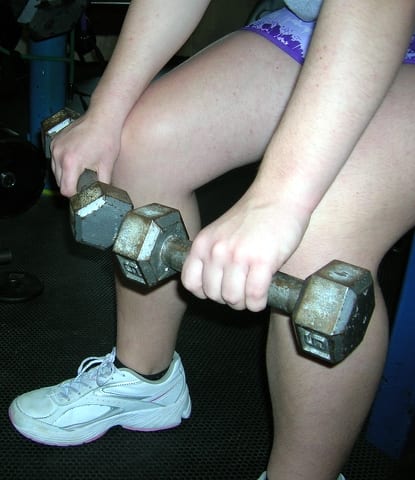Have you ever shaken the hand of a coal miner or a carpenter? You may find they have strong, sometimes even crushing, handshakes. This is due to years of working with their hands and forearms, creating good grip strength.
And, why are the best American Ninja Warriors also rock climbers? They, too, have good grip strength, not just with their hands, but also with their fingers.
There are three different types of grip strength:
■ With the pinch grip, you pinch an object between your fingers and thumb. The fingers are mostly extended and rely greatly on the musculature around the thumb joint.
■A crush grip is used when you wrap your hand around an object, such as a drinking glass. The fingers are generally flexed and there is little to no reliance on thumb strength.
■ The support grip is used when you hold or carry an object, such as a bucket, for a long period of time.
All three grips work your flexor muscles in the closing of your grip.
To maintain equal balance in your grip, it is important to work the opposing muscles, which are the extensors that work the opening of your grip.
Both your finger extension and wrist extension are important to maintain a good muscle balance and grip strength. For example, opening up your hand and extending your fingers in a stretch position works your extensors.
Maintaining a good muscular balance in your hand and wrist will help to prevent hand injuries such as tendinitis and carpal tunnel syndrome. Many times, these occur because of overuse in a certain position, which can cause a muscular imbalance.
Grip strength is important for athletes, especially a wrestler when holding on to an opponent or a ball player when catching or throwing a ball. Most athletes, whether holding on to a ball, a hockey stick or parallel bars, depend on their grip strength for a good performance.
Everyone can benefit from grip strength. Have you ever caught yourself while falling? Having good grip strength can prevent many falls from happening.
Here are some ways to improve your grip strength:
■ Take a plate or a thin object and pinch it between your fingers and thumb. Hold for a minute, or see how long you can hold it.
This works your pinch grip. Perform this exercise two times a week. Use a weight heavy enough to challenge your pinch grip strength.
■ To work your forearms for a better crush grip, perform wrist curls using dumbbells. Hold dumbbells in your hands resting over your knees and slowly roll your dumbbells in your hands up and down about 20 times. Do forward curls with hands up and reverse curls with hands down.
Normally, you can do more weight with forward wrist curls than reverse wrist curls, but it is important to work both the forward and reverse motion to maintain muscular balance. This works both your flexor and extensor muscles.
■ Barbell wrist curls are similar to dumbbell wrist curls. They are performed the same way in the forward and reverse positions about 20 times each, two times per week.
■ Another exercise to work your forearms is wrist rolls. Use a bar with a weight attached on a string and then roll the weight up and down. Perform wrist rolls one or two times, both in the forward and reverse positions, two times a week.
■ A more advanced exercise to develop grip strength is the dead lift. This is performed with a bar or with dumbbells by picking the weight up off the floor. Not only does this exercise work your back, it also works your grip strength.
Technique is important in this exercise, so it is recommended that you work out with a professional trainer when performing the deadlift. This exercise is highly recommended for athletes.
■ Doing the “farmer’s walk,” you walk holding dumbbells for a distance. This particular exercise works your support grip and your muscular endurance when maintaining a grip for a long period of time.
This exercise is great for an athlete who has to have good muscular endurance.
Creating good grip strength can take years of practice and it is important to work both directions in the open and closed position to maintain muscular balance. Training only the closed grip (pinch, crushing and support) will cause a muscular imbalance that could lead to tendinitis and carpal tunnel syndrome.
Once you have that grip strength, it seems to stay. My father, who retired more than 20 years ago as a carpenter from Bethlehem Steel, at age 82 still has large hands, muscular forearms and a very impressive crushing handshake.
Snyder is the co-owner of TransFitness Personal Training.



